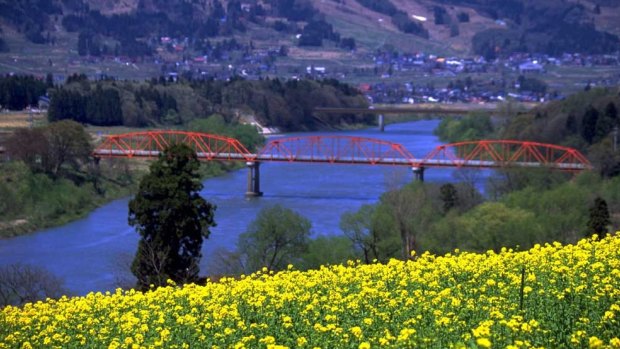By Roger Balch

Rapeseed Blossom Field, Iiyama, Nagano Prefecture, Japan.
SPONSORED CONTENT
Japan's Shin-etsu Trail - easily accessible from Iiyama station on the Hokuriku Shinkansen (bullet train) from Tokyo - runs for 80 kilometres along the Sekida Mountain ridge, which makes up part of the border between Nagano and Niigata Prefectures on the main island of Honshu.
Abundant with earthy, elevated delights this trail offers hikers inspirational scenery and a heightened sense of awareness of the world around them.
The mountain range is cloaked by a sprawling forest of ancient beech trees and the hard-packed soil underfoot makes for easy walking. There are views of mountain streams and waterfalls, banks of snow left behind after winter, and colourful camellia trees blooming reddish flowers. Hikers seeking plentiful nature will be delighted by the Shin-etsu Trail as its forest is best known for its beech trees, the most ancient of which are over 400 years old. These tall, well-shaped trees alongside the path act as a virtual "green dam" that stores vast quantities of water and protects the mountains from erosion and landslides.
Hiking can be an almost mystical experience, and mountains and forests especially are often associated with spirits and considered to be places of enlightenment.
This hike is a modern example of Japanese mountain asceticism, known as shugendo, whose followers stress physical endurance as the path to enlightenment – including sitting or standing under icy mountain waterfalls or in deep snow. They also set up wood or stone markers along mountain trails, and along the trail there's a stone monument called Taishoujin-ato showing that in the 16th century a warlord called Kenshin led his men through the area on his way to the Battle of Kawanakajima.
Not every hike has to be a wilderness experience; the people you meet along the way can be as enriching as the nature. Although you can camp along the Shin-etsu Trail, a more rewarding experience may be staying in a local minshuku down in the Iiyama Valley. (Minshuku are family-operated, Japanese-style bed and breakfasts that offer trekkers the opportunity to meet local families and experience the traditional lifestyle.)
Many hiking misfortunes are the result of walkers pushing themselves too far and too hard so it's important to walk within your limits. Shin-etsu offers treks for beginners and seasoned walkers at various levels of fitness. And the minshuku owners will often be happy to drive you to and from the appropriate trail heads, which means you can also make day trips up to the trail.
Spring to early summer (from mid-June to the end of July) is an especially good time to visit the trail: it's when the last traces of snow can be seen among new greenery and flowers bursting into bloom, especially those of the camellia trees. In autumn (from mid-September to the end of October) hikers can enjoy the brilliant colours of fall leaves.
Wherever and whenever you walk, a reliable guide is essential, either in written or human-being form. The latter are readily available in Shin-etsu. Not only will they help keep you safe, the information they provide will enrich your hiking beyond measure.
For example, they may help you spot and identify local wildlife. As you strive step after step, thinking lofty thoughts and getting in touch with your inner wilderness warrior, you may stumble across a tanuki: a foxlike raccoon dog, stylised statues of which adorn inns across Japan.
In these saucy statues, in addition to holding a sake flask, the tanuki display a pair of bulging testicles that play an important part in their mythical shape-shifting abilities. Legend says they have been known to use their testicles as makeshift raincoats, weapons and drums.
Wherever you choose for your next hike, the most important piece of hiking equipment is a pair of expertly fitted and chosen hiking boots that have been thoroughly broken in. Your backpack should be big enough for the essentials but not so heavy that it will weigh you down: you want an enjoyable experience not an unrelenting slog. Water, sunscreen, rain gear and insect repellant are of course essential, and a small yet good-quality camera will let you capture your memories and share your experience with others.
Hiking is one of the most rewarding outdoor pursuits. For some it's a way to achieve major life goals, others are happy to just sit and gaze at beautiful sunsets and waterfalls. Whatever you're after, every journey does, as the saying goes, start with a single footstep.
See also: Must-have Japanese food you've never tried
See also: Undiscovered Japan by Road
This article is brought to you by Japan National Tourism Organization.
Looking for a warm getaway during the Australian winter? Find the best travel ideas for summer in Japan, along with inspiration and travel tips at Japan National Tourism Organization's website, jnto.org.au
Sign up for the Traveller Deals newsletter
Get exclusive travel deals delivered straight to your inbox. Sign up now.